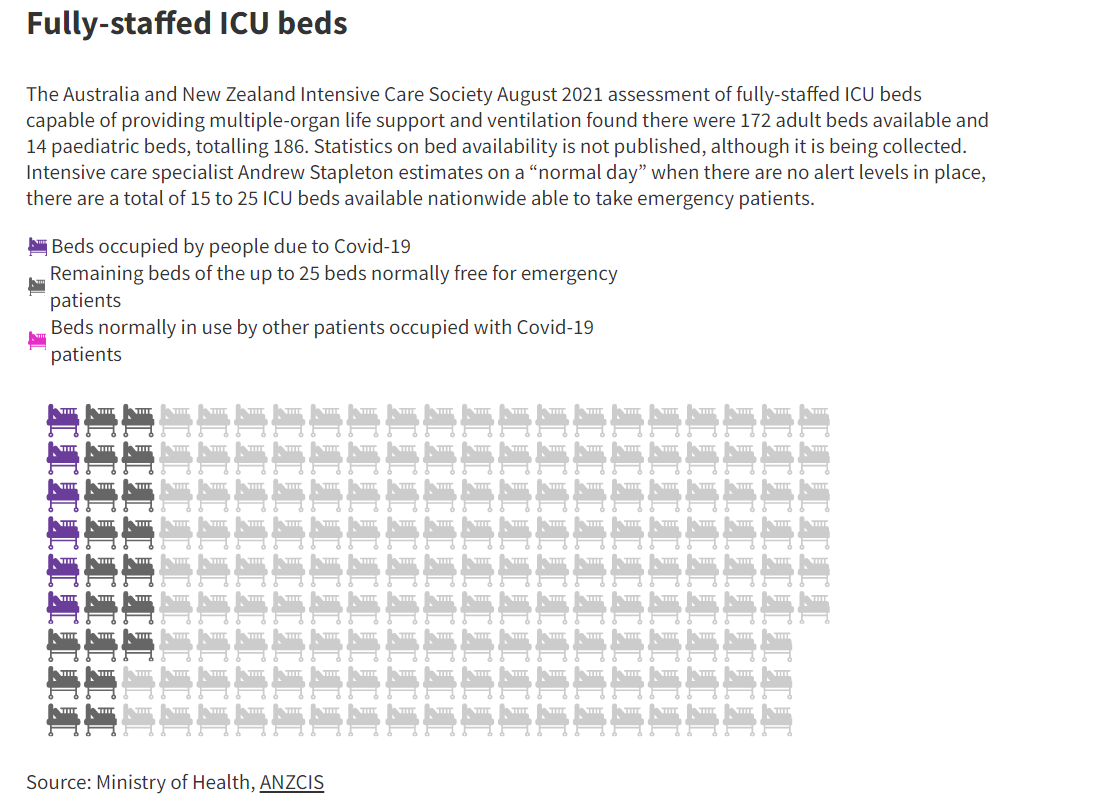卫生总干事说,奥克兰边境的解除不会导致Covid-19病例的突然激增,但有些病例会可能会渐渐地在全国各地出现。
Shaun Hendy教授和他的团队为政府进行的数据建模显示,最坏的情况是每周会有16000个新增病例。
Ashley Bloomfield博士表示,Aotearoa目前没有达到这些数字的迹象。 同时他对《Morning Report (晨报)》表示,他还没有看到一个模型能准确显示疫情何时达到高峰。”模型只是向你展示了未来可能发生的情况,所以它并不会预言什么将会发生…… 最坏的情况是预测1月份有16,000个病例,但根据目前的情况来看,这种情况发生的概率几乎是不存在的。”
他还表示,疫苗的接种率仍然是首要任务。在奥克兰的Delta疫情爆发之初,完全接种两针疫苗的比例约为23%,现在已经达到90%,并且在全国各地这个数据仍在不断攀升。
三个月内,根据模型的预测,奥克兰的新增病例数在七天内的平均数不会超过每天200例,这个数值可能会在11月底达到每天200例的高峰,该市有希望稳定控制在这一水平。Bloomfield博士同时表示,R点的值是1.2,并且这一情况已经持续了几个星期。
“最为关键的一点是,即使这个边境限制被解除,特别是要求人们要么接种疫苗,要么进行Covid测试,我们也不会看到那种一夜之间从200个病例突然激增到1000个或更多病例的情况。”
“是的,在现在,或是说将来的情况下,我们能看到全国各地的可能存在风险的潜在病例,但我相信我们的接触者追踪技术和Covid测试能够帮助我们应对这些情况。”
当被问及哪些地方最有可能发生死亡和严重疾病时,Bloomfield博士说未接种疫苗的人风险最大。特别是毛利人和偏远农村地区的人位居风险榜首,目前他们正在努力提高这部分人群的疫苗接种率。
“这对于防止住院和死亡真的很关键。我们在奥克兰已经看到了这种做法的好处”。
疫情爆发三个月后,奥克兰有超过80人住院,6人在接受重症监护。这两个数字在最近几周已经趋于平稳。
“我们不会走到让医院系统不堪重负的地步。我们可以采取一些行动……”

图片注解: 澳大利亚和新西兰重症监护协会2021年8月对ICU床位进行评估,这些ICU床位要求能够提供多器官生命支持和呼吸辅助系统,统计数据发现有172张成人床位和14张儿科床位,总计186张。关于病床可用性的统计数据因为正处于收集阶段所以没有公布。重症监护专家Andrew Stapleton估计,在一个 “正常的日子 “里,当没有警报级别时,全国共有15至25张ICU床位可以接收紧急病人。
90%的疫苗接种目标并没有被放弃。交通灯系统提供了一个保护框架,对未接种疫苗的人提供了比目前2级警报更多的保护。
他说,红灯大大限制了人们进入病毒容易传播的环境。在欧洲,现在是冬季,一些国家正在重新采取相关措施。
“与欧洲相比,我们的优势是,我们将进入夏季,而不是冬季,这一点极为重要。”
根据数据显示,奥克兰人在夏季主要前往Northland、Waikato和Coromandel,Bloomfield博士表示他们正在努力在这些地区进行大量的测试和追踪。
Bloomfield博士为目前的密切接触者的追踪系统辩护,说它能够处理任何激增的病例数。他同时表示,现在接触者追踪系统没有问题,卫生部有更多的人加入,并且有更多的人在夏季待命。
“我们有足够的接触者追踪能力,你可以看到,这在我们迄今为止在北岛和其他地方出现的那些病例中发挥了关键作用,实际上我们已经能够通过使用接触者追踪来迅速接触并控制这些病例。”
The lifting of Auckland’s border will not lead to a sudden surge in Covid-19 cases but some will pop up across the country, the Director-General of Health says.
Modelling carried out by Professor Shaun Hendy and his team for the government shows a worst-case scenario of 16,000 weekly cases.
Dr Ashley Bloomfield said Aotearoa is not on track to hit those numbers.
He told Morning Report he has not seen a model showing exactly when the outbreak will reach its peak.
“Modelling shows you what might happen in the future so it doesn’t predict what will happen… The worst case scenario is predicting 16,000 cases in January but that’s not what our current trajectory is and that is not what we are anticipating will happen.”
He said vaccination rates remain the top priority. At the start of the Delta outbreak in Auckland the rates were around 23 percent fully vaccinated and are now 90 percent and are climbing around the country.
Three months in, the modelling projected the number of cases in Auckland would be fewer than 200 cases a day on average over seven days, peaking at 200 per day at the end of November which the city was still on track to have.
The R point value is 1.2 which it has been for some weeks, he said.
“The key point is that even once that boundary lifts, especially with the requirement on people to be either vaccinated or tested, we’re not going to see that sudden surge from 200 to 1000 or more cases overnight.
“Yes, we will see seeding of cases around the country which we are seeing now but in that situation our contact tracing and testing is able to respond and get around those cases.”
Asked where deaths and serious illnesses will be most likely to occur, he said unvaccinated people are the most at risk.
Māori and those in remote rural areas were at the top of the list and there were ongoing efforts to lift their vaccination rates.
“This is really critical to preventing hospitalisations and deaths. We have seen the benefit of that in Auckland.”
Three months into the outbreak just over 80 people are in hospital in Auckland, and six are in intensive care. Both figures had levelled off in recent weeks.
“We’re not going to get to a point where we are going to let the hospital system get overwhelmed. There are actions we can take…”
The 90 percent vaccination target has not been abandoned. The traffic light system provides a protection framework that offers greater protection to the unvaccinated than the current alert level 2.
The red light greatly restricts people’s ability to go into settings where the virus spreads easily, he said.
In Europe, where it is winter, measures are being re-introduced in some countries.
“The advantage we have over Europe is that we’re going into summer, not winter, and that’s hugely important.”
Other data he had seen showed that Aucklanders over summer headed mainly to Northland, Waikato and the Coromandel and efforts are being made to bulk up testing and tracing in those areas.
Dr Bloomfield defended the current contact tracing system, saying it would be able to handle any surge in case numbers.
There is no problem with contact tracing now and the Ministry of Health has more people coming in and more on standby for the summer.
“We have plenty of contact tracing capacity and you can see that that has played a key role in where we have had those cases to date seeding in Northland and other places around the North Island that actually we have been able to shut those down very quickly with the use of contact tracing.”
9,366 views




